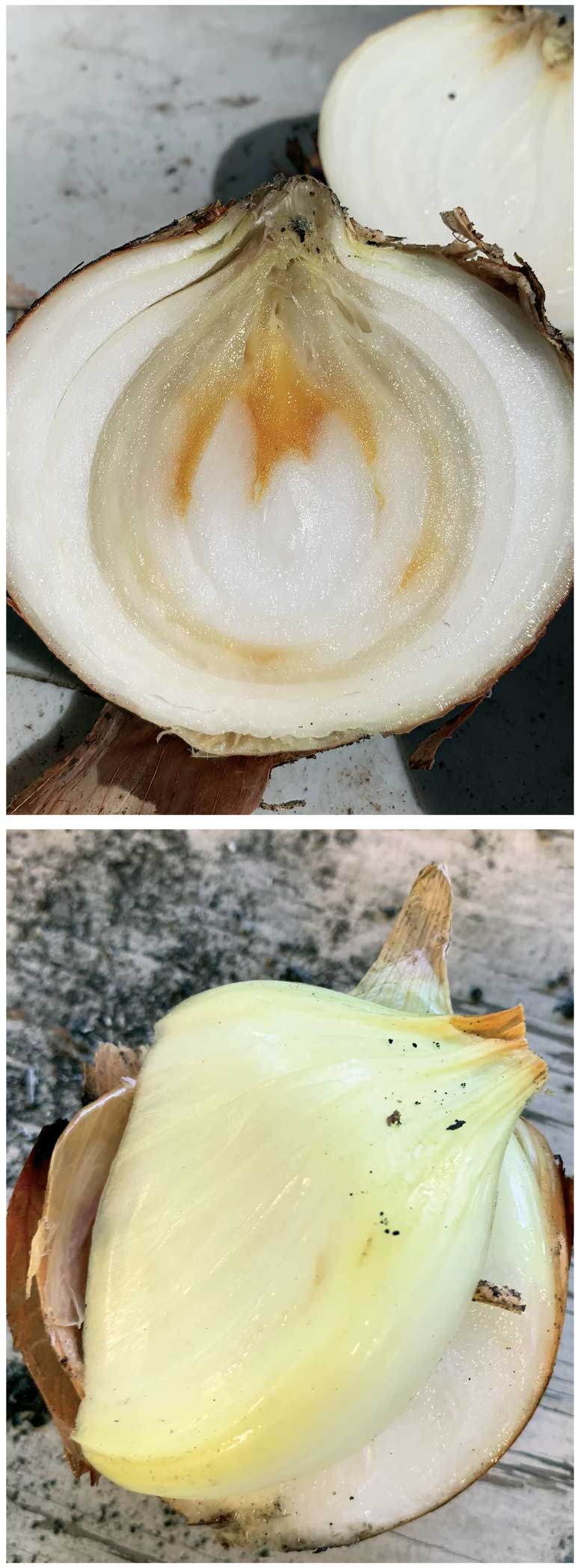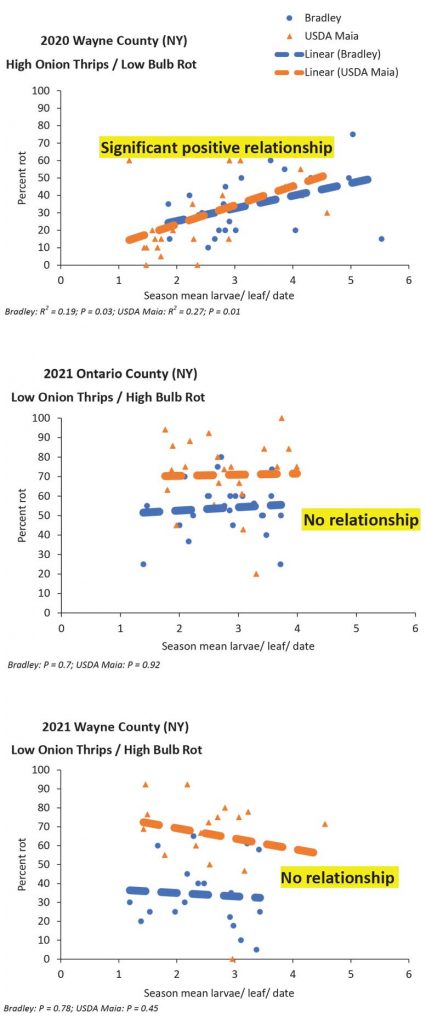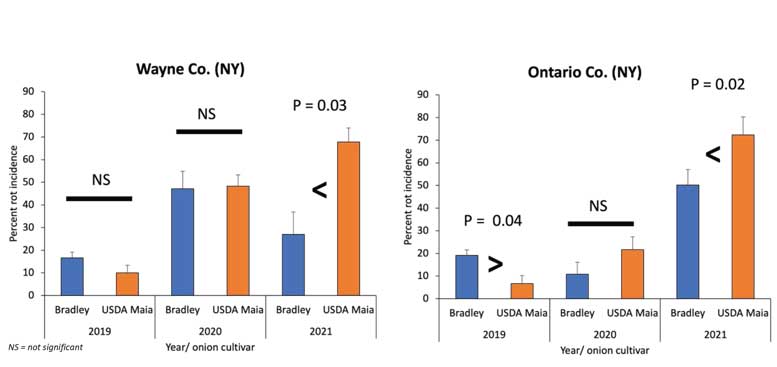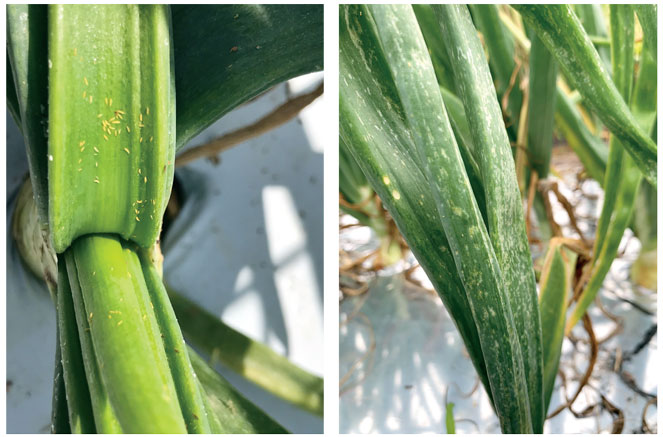|
Click to listen to this article
|
By Pin-Chu Lai and Brian Nault, Department of Entomology, Cornell University, Cornell AgriTech
Do your onions suffer from onion thrips infestations and bacterial bulb rot? If you grow dry bulb onions, our research findings might interest you.
Onion Thrips, Bacterial Bulb Rot
Onion thrips (Fig. 1) is considered one of the most important insect pests of onions because they cause leaf damage that can not only reduce bulb yield by decreasing photosynthesis efficiency, but their feeding also creates wounds on leaves, making the plant more vulnerable to disease-causing pathogens.
Bacterial bulb rot (Fig. 2) is also a serious problem in dry bulb onion production. Bulb rot-causing bacteria are everywhere in the soil and can infect onion bulbs through wounds on either leaves or bulbs as well as through the neck opening in the leaf axils.
When onion thrips and bulb rot-causing bacteria infest onion plants simultaneously, it is possible that leaf damage caused by thrips feeding could facilitate bacterial infections. In dry bulb onion production in Michigan, an increase in thrips densities and damage was correlated with an increase in bacterial leaf and stalk necrosis incidence; however, the subsequent bacterial bulb rot incidence was not measured. In contrast, no consistent association has been found between onion thrips abundance and bacterial bulb rot incidence in conventionally produced onions in muck fields in New York.
Recently, we further examined the relationship between onion thrips and bacterial bulb rot incidence, specifically in organic onion production systems in New York.

On-Farm Trials
Field trials were conducted in 2020 and 2021 on two certified organic farms in Ontario County and Wayne County, New York. Two onion storage varieties, “Bradley” (waxy leaf) and “USDA Maia” (semi-glossy leaf), were transplanted in raised beds covered with reflective mulch and equipped with drip irrigation.
We designed the study to have a range of thrips infestation levels, which were created by making foliar applications of Entrust SC to small plots at varying frequencies based on thresholds of one, three or five thrips per leaf. Thrips abundance was assessed weekly, and the season average number of thrips larvae per leaf was used in our analysis.
Onions were harvested at the end of the season, and a sub-sample of the largest bulbs were cut in half longitudinally to assess the number of bulbs with bacterial rot.
Incidence of bacterial bulb rot was very high in all three trials (trial average bulb rot incidence: Wayne County 2020: 48 percent; Wayne County 2021: 44 percent; Ontario County 2021: 62 percent). Thrips abundance ranged from 1.2 to 5.5 thrips/leaf in Wayne County 2020, 1.2 to 4.6 thrips/leaf in Wayne County 2021, and 1.4 to 4 thrips/leaf in Ontario County 2021.
For both onion varieties, there was no relationship between the incidence of bacterial bulb rot and the season mean thrips density in two of three trials (Fig. 3 middle, bottom). Higher thrips abundance resulted in more bulb rot in the trial in Wayne County 2020 (Fig. 3 top). The incidence of bacterial bulb rot was high overall in 2021 regardless of thrips abundance (Fig. 3 middle, bottom), which was most likely due to extensive rainfall in July and August 2021 (total precipitation in July and August 2021 in Wayne County: 10.2 inches; Ontario County: 12.1 inches) that created favorable conditions during bulbing for bacterial bulb rot disease to develop.
The higher incidence of bulb rot in “USDA Maia” in 2021 (Fig. 3 middle, bottom) may catch your eye. However, “USDA Maia” was actually not more susceptible to bulb rots than “Bradley.” In four of six trials, “USDA Maia” had the same or lower bacterial bulb rot incidence than “Bradley” (Fig. 4). The only times when “USDA Maia” had higher bulb rot incidence than “Bradley” was in 2021 when there was an extremely wet period during bulbing.

Management Recommendations
Based on our results and previous studies in conventionally grown onions, high thrips infestations may occasionally increase the threat of bacterial bulb rot infection, but only when thrips pressure is very high (season average >3 thrips/leaf). Therefore, we do not recommend spraying more intensively for thrips to reduce bacterial bulb rot as the benefits of doing so are not guaranteed. On the other hand, wet growing conditions during bulbing appear to be the most important factor exacerbating bacterial bulb rot disease development.
Authors’ note: Information in this article is part of research that has recently been published: Lai, P. C., Iglesias, L., Groves, R. L., Havey, M. J., & Nault, B. A. (2022). Performance of a semi-glossy onion hybrid in certified organic onion fields infested with Thrips tabaci and bulb rot-causing bacteria. Crop Protection, 106037, www.doi.org/10.1016/j.cropro.2022.106037).
Please contact Pin-Chu Lai (pl484@cornell.edu) with any questions or comments.


